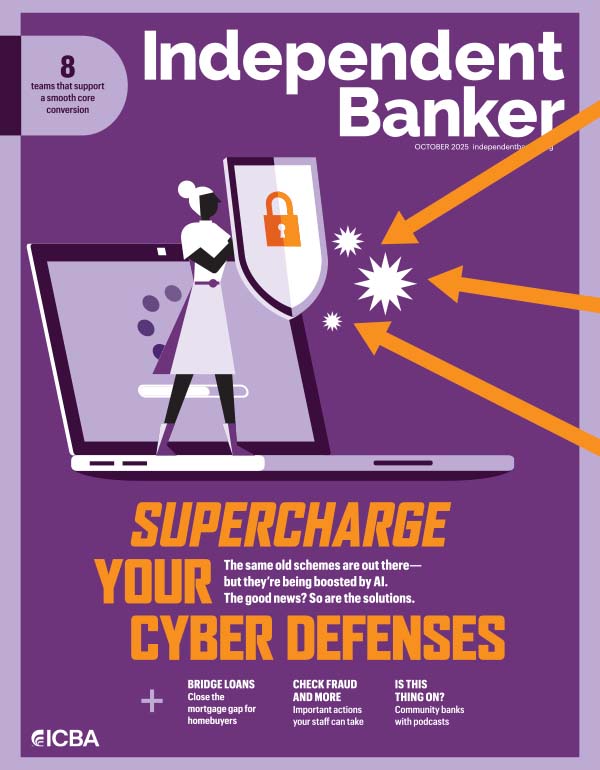Board management is a very people-based practice, but it can often be overwhelming to wrangle a large group of people, whether you’re trying to schedule a meeting or get on the same page about bank decisions and policies. That’s why some community banks have chosen to adopt board software, which can enhance information-sharing and other efficiencies and therefore lighten the load.
While there are several providers of board software, and features can vary, these platforms generally offer password-protected access to essential documents and informational materials, as well as communication tools to make boards function more efficiently and effectively.
“It’s a way to categorize and store information for board members,” says Troy A. Peters, president and CEO of $940 million-asset Jonestown Bank & Trust Co. (JBT) in Jonestown, Pa.
What else does board management software have to offer? Here’s a look into the efficiencies that could come with implementing a platform.
Organizational efficiencies
Having board software can be a significant timesaver for banks and boards. In a paper-based system, if a board planned to meet on Wednesday, everything might have to be printed the previous Friday. Before adopting board software more than a decade ago, CEO Jeff Dick notes that his bank, $2 billion-asset MainStreet Bank in Fairfax, Va., was printing about 250 pages, 11 times a year, for each of its 11 directors. This amounted to more than 30,000 pages annually.
But with board software, relevant materials can be dragged and dropped into a folder and changed—even up to the last minute if necessary. “Three minutes before the board meeting, we could make a major change and everyone would get it,” says Dick.
JBT has also been using board software for about 10 years, and Peters loves how much paper the bank saves. “It literally saves reams and reams of paper and time compiling this stuff to send out,” he says.

Ryan Gilkerson, president and chief executive of Community Bankers of West Virginia, likes the ability to send the board’s agenda online through the state association’s platform and upload meeting notes as well as any relevant documents. “It keeps us more organized and more on task,” he says.
Communicating more clearly
Quick Stat
30K
The number of paper pages used by MainStreet Bank annually before switching to board software
MainStreet Bank uses the board management platform to provide relevant online reading material directly to its directors. This can include information on topics related to the bank’s business lines, the economy and market-share insights—materials that might be difficult or cost-prohibitive to print out in bulk, Dick says.
Directors can also make notes on documents and share those notes with other directors. No one else can see the notes unless the person shares them, Dick adds, noting that the community bank also uses the platform for some of its management committees. It’s all cloud-based, so the bank doesn’t have to worry if there’s a fire or another issue at its offices, he says.
Gilkerson likes that the board software platform his association uses links directly to Zoom—a bonus for meetings that not everyone can attend in person, he says.
Even banks that have been using board software for years may be able to benefit from new functionality, says Josh Palmer, head of content at board software provider OnBoard. He recommends community banks ask their provider about new or additional features that could be helpful.
OnBoard, for instance, has a feature that allows digital voting for loan committees. This allows loan committees to approve or reject loans in essentially real time without the need to meet in person or digitally, Palmer says.
The provider also recently launched a secure AI feature. If a board member has a question about something in the packet, such as the bank’s financial goals for 2025, AI helps answer the question, Palmer says. He adds that, importantly, the data isn’t fed into an outside large language model; it stays within each customer’s portal.
Addressing security concerns
With board software, it’s easy to track who has signed into the portal for added security. Before switching to board software, JBT had little control over how board members stored or disposed of bank-related materials they were no longer using, despite its best efforts to keep close tabs, Peters says.
“We look at paper as one of the least secure forms of storing information, because it can get lost, it can get mislaid and it can get compromised or stolen,” he says. “It can also get photocopied and disseminated.”
Banks can also set up rules related to where the software can be used. MainStreet Bank, for instance, typically only allows directors to use it on a bank-issued iPad.
In terms of cost, fees for board software platforms can vary depending on factors such as the number of users and enabled features, but bankers say it’s worth the expense.
According to Dick, “It probably saves us at least one full-time equivalent employee.”






